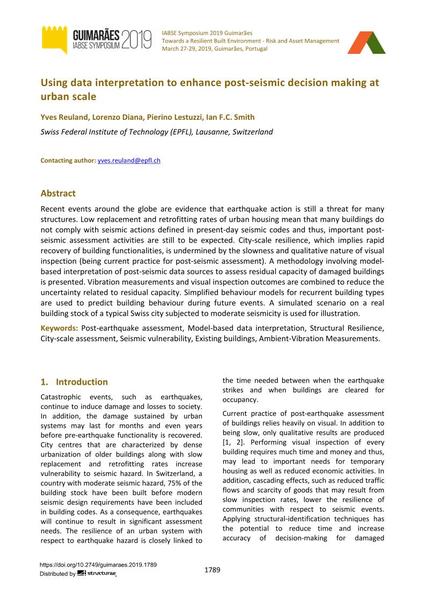Using data interpretation to enhance post-seismic decision making at urban scale

|
|
|||||||||||
Bibliografische Angaben
| Autor(en): |
Yves Reuland
(Swiss Federal Institute of Technology (EPFL), Lausanne, Switzerland)
Lorenzo Diana (Swiss Federal Institute of Technology (EPFL), Lausanne, Switzerland) Pierino Lestuzzi (Swiss Federal Institute of Technology (EPFL), Lausanne, Switzerland) Ian F. C. Smith (Swiss Federal Institute of Technology (EPFL), Lausanne, Switzerland) |
||||
|---|---|---|---|---|---|
| Medium: | Tagungsbeitrag | ||||
| Sprache(n): | Englisch | ||||
| Tagung: | IABSE Symposium: Towards a Resilient Built Environment Risk and Asset Management, Guimarães, Portugal, 27-29 March 2019 | ||||
| Veröffentlicht in: | IABSE Symposium Guimarães 2019 | ||||
|
|||||
| Seite(n): | 1789-1796 | ||||
| Anzahl der Seiten (im PDF): | 8 | ||||
| DOI: | 10.2749/guimaraes.2019.1789 | ||||
| Abstrakt: |
Recent events around the globe are evidence that earthquake action is still a threat for many structures. Low replacement and retrofitting rates of urban housing mean that many buildings do not comply with seismic actions defined in present-day seismic codes and thus, important post- seismic assessment activities are still to be expected. City-scale resilience, which implies rapid recovery of building functionalities, is undermined by the slowness and qualitative nature of visual inspection (being current practice for post-seismic assessment). A methodology involving model- based interpretation of post-seismic data sources to assess residual capacity of damaged buildings is presented. Vibration measurements and visual inspection outcomes are combined to reduce the uncertainty related to residual capacity. Simplified behaviour models for recurrent building types are used to predict building behaviour during future events. A simulated scenario on a real building stock of a typical Swiss city subjected to moderate seismicity is used for illustration. |
||||
